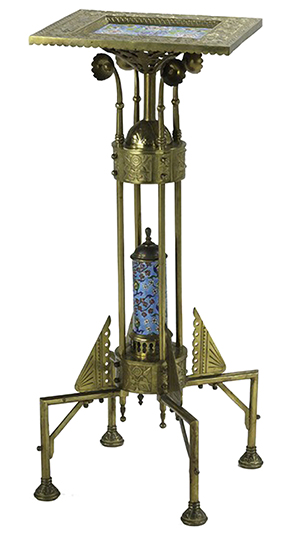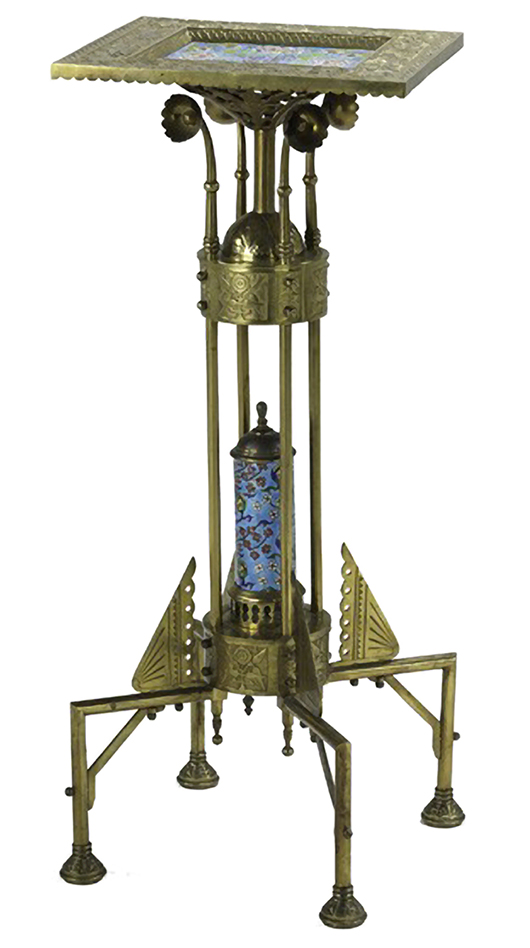
Starting in about 1885, plants were among the decorations in a house because central heating kept homes – and plants – warm in the winter, and glass windows let light into most homes. Only a small group of plants were popular, partly because of the look of the foliage, partly because they could tolerate the dry air of the home. Boston ferns, Maidenhead ferns, palms, jasmine, citrus trees, aspidistra and mother-in-law’s tongue (sansevieria) were most common. A houseplant required a large decorative pot, so ceramic jardinieres consisting of a pedestal and bowl were made by many companies like Roseville and Weller. Wooden pedestals to hold potted plants were made by Victorian cabinetmakers like Mitchell & Rammelsberg of Cincinnati, and companies like Bradley and Hubbard of Meriden, Conn., made metal plant stands. Because fewer plant stands were made than more common furniture forms like chairs, it is hard to find an interesting vintage stand. Prices are high.
Q: About 25 years ago, I bought a modern-looking side table just because I liked it. The other day I noticed that it’s signed “Johan Tapp.” What do you know about him?
A: Johan Tapp (1888-1939) was a Dutch designer. His furniture designs, many with a midcentury modern look, were apparently manufactured and sold by various companies. Today his pieces can sell for $200 to $2,000 or more.
Q: I have a pyrography-decorated wooden wall plaque of five kittens. It’s about 12 by 8 inches. On the back, it’s marked “Flemish Art Company, New York” and “866.” Can you tell me anything about it or its value?
A: The word “pyrography” means “writing with fire.” It’s sometimes called “pokerwork” because the design is burned into the wood with a thin poker-like tool. The earliest examples were done in China more than 2,000 years ago. The technique became popular in the United States in the late 1800s, when a method of coloring the designs by using benzoline was developed. By the early 1900s, boxes, candlesticks, plaques, novelties and furniture were being decorated with pyrographic designs. The Flemish Art Co., also known as Flem-Ar-Co, was the major producer of pyrographic items in the United States. The term “Flemish art” is sometimes used generically to refer to any pyrographic work. The company was in business in the late 1800s and early 1900s and sold finished pieces, unfinished pieces, woodworking supplies and pyrographic kits through Sears, Roebuck & Co. catalogs. Pyrographic wall plaques usually sell for less than $10 today.
Q: We have two vintage convertible highchair strollers. They are both made of wood and have steel wheels. One is faux bamboo. When it’s converted to a highchair, the stroller wheels rise up and the stroller handle converts to solid chair legs. The other chair is plain wood with a cane seat. The wheels on this chair stay on the ground when the seat is raised to make a highchair. Do you know which chair is older? And what are the chairs worth?
A: A patent for a highchair similar to your chair with a cane seat was granted in the 1940s, while a patent for a highchair matching your faux bamboo chair was granted in the 1950s. So both of your highchairs are probably at least 50 years old. But a child should not be seated in one of them today. Neither is safe nor reliable. Still, a collector might pay $150 to $175 for each chair.
Q: In 2001 my wife and I bought a Thomas Kinkade painting, The Garden of Prayer, and donated it to our church in memory of our parents. Along with the painting, we gave the church a certificate of limitation and authenticity and a warranty registration card that listed the painting as “3073/4850 S/N Paper.” Unfortunately, the church has lost these documents. Can the certificate and warranty be replaced? What is the value of the painting?
A: You have a limited edition print of one of Thomas Kinkade’s most popular paintings. Limited edition prints were made in various sizes on either canvas or paper. Yours is on paper, which is less valuable than a print on canvas. The size of the print and how it’s framed also affect its value. Thomas Kinkade died earlier this year, but his company still is in business and can be contacted via its website, ThomasKinkade.com. Someone there can tell you about replacement documentation for the print. Prices for Kinkade prints have gone down in the past few years.
Q: My gold-trimmed Limoges fish plate has two marks on the bottom. One is green with the words “Limoges” and “France” divided by a horizontal arrow. The other is red with the circled initials “AK” above “CD.” Outside the circle are, again, the words “Limoges” and “France.” Please tell me who made the plate, how old it is and what it’s worth.
A: It’s likely that the two marks on your plate were made by two different companies in Limoges: the green mark by the company that made the plate, and the AK/CD mark by the decorating firm. Experts think the AK stands for A. Klingenberg, and the CD for Charles Dwenger – two decorating firms that may have merged in the mid-1890s. The mark appears on dishes made between about 1895 and 1910. Limoges fish plates the age and quality of yours sell for $150 or more.
Tip: If a vintage fountain pen cap or barrel is discolored, the pen has little value.
Need prices for collectibles? Find them at Kovels.com, our website for collectors. More than 84,000 prices and 5,000 color pictures have just been added. Now you can find more than 856,000 prices that can help you determine the value of your collectibles. Access to the prices is free at Kovels.com/priceguide.
Terry Kovel answers as many questions as possible through the column. By sending a letter with a question, you give full permission for use in the column or any other Kovel forum. Names, addresses or email addresses will not be published. We cannot guarantee the return of any photograph, but if a stamped envelope is included, we will try. The volume of mail makes personal answers or appraisals impossible. Write to Kovels, Auction Central News, King Features Syndicate, 300 W. 57th St., New York, NY 10019.
CURRENT PRICES
Current prices are recorded from antiques shows, flea markets, sales and auctions throughout the United States. Prices vary in different locations because of local economic conditions.
Thermos, Barbie, photo of ponytail Barbie on all sides, navy ground, red cup, 1962, $45.
Depression glass cake plate, Dogwood pattern, pink, 10 inches, $80.
Bakelite dress clips, inverted triangles, amber with inset red and green semicircles, V shape, E.A. Phinney Co., 1931, 2 3/4 in., set of four, $115.
Fenton perfume bottle, Coin Dot pattern, white opalescent, King’s Crown top, 4 1/2 inches, $200.
Political button, Charles Evans Hughes, 1916 Republican candidate (lost to Woodrow Wilson), portrait in center, attached whiskbroom signifying clean sweep, 1 1/4 x 1 3/4 inches, $255.
Brass safe-maker’s advertising plate, depicts potential fire damage to a business, marked “Farrel, Herring & Co., May 18th 1852,” Philadelphia, 7 x 5 inches, $295.
“George Washington” desk, mahogany, seven drawers, side galleries, turned legs, 36 x 72 inches, with matching side stand, 1950s, 23 x 21 inches, $1,285.
Garton Space Cruiser pedal car, spaceship form, white, red steel wheels, black rubber tires, 47 inches, $1,550.
Copeland Spode bowl, gilt-decorated cherubs flanking rococo bowl with cutwork, exterior with turquoise ribbon design, scrolled feet, 1880s, 10 x 5 inches, $1,850.
Doll, Lenci, equestrian, molded pressed felt, green side-glancing eyes, yellow mohair wig, riding crop, 27 1/2 inches, $5,750.
Available now. The best book to own if you want to buy, sell or collect – and if you order now, you’ll receive a copy with the author’s autograph. The new Kovels’ Antiques & Collectibles Price Guide, 2013, 45th edition, is the most accurate source for current prices. This large-size paperback has more than 2,500 color photographs and 40,000 up-to-date prices for more than 775 categories of antiques and collectibles. You’ll also find hundreds of factory histories and marks, a report on the record prices of the year, plus helpful sidebars and tips about buying, selling, collecting and preserving your treasures. Available online at Kovelsonlinestore.com; by phone at 800-303-1996; at your bookstore; or send $27.95 plus $4.95 postage to Price Book, P.O. Box 22900, Beachwood, OH 44122.
© 2012 by Cowles Syndicate Inc.

ADDITIONAL IMAGE OF NOTE


